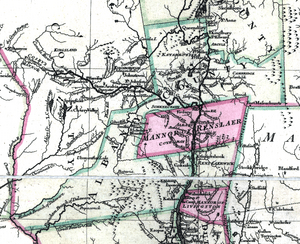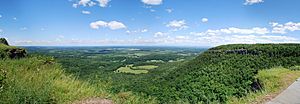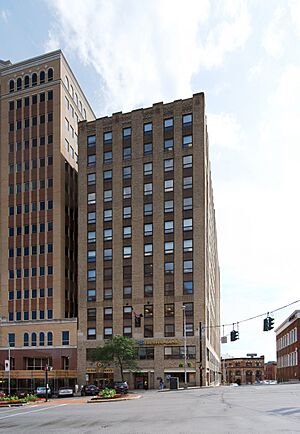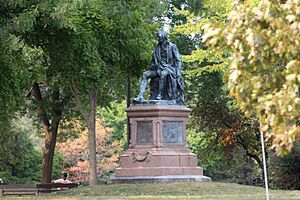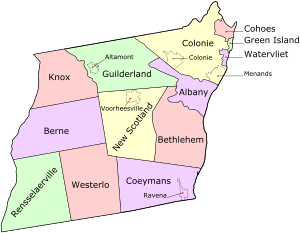Albany County, New York facts for kids
Quick facts for kids
Albany County
|
|||
|---|---|---|---|
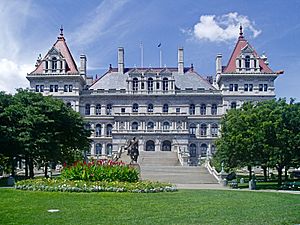
|
|||
|
|||
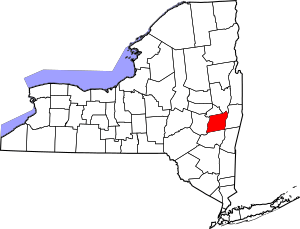
Location within the U.S. state of New York
|
|||
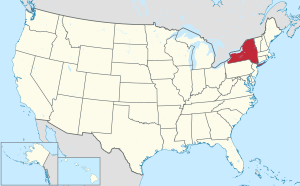 New York's location within the U.S. |
|||
| Country | |||
| State | |||
| Founded | November 1, 1683 | ||
| Named for | Prince James, Duke of York and of Albany | ||
| Seat | Albany | ||
| Largest city | Albany | ||
| Area | |||
| • Total | 533 sq mi (1,380 km2) | ||
| • Land | 523 sq mi (1,350 km2) | ||
| • Water | 10 sq mi (30 km2) 2.0% | ||
| Population | |||
| • Estimate
(2020)
|
314,848 | ||
| • Density | 602.13/sq mi (232.48/km2) | ||
| Time zone | UTC−5 (Eastern) | ||
| • Summer (DST) | UTC−4 (EDT) | ||
| Congressional district | 20th | ||
Albany County is a county in the state of New York, United States. Its northern border is the Mohawk River, where it meets the Hudson River to the east. In 2020, about 314,848 people lived here. The main city and county seat is Albany, which is also the capital city of New York State.
Albany County was named after Prince James, who was the Duke of York and Albany. The county is part of a larger area in New York called the Capital District.
Contents
History of Albany County
Early Days: Colonial Times
After England took over New Netherland from the Dutch, Albany County was created on November 1, 1683. This was done by New York Governor Thomas Dongan. At first, the county's borders were not very clear. They included towns like Albany, Schenectady, and other Christian settlements along the Hudson River.
In 1772, when Tryon and Charlotte counties were formed, Albany County got clearer boundaries. It then included areas that are now Albany, Columbia, Rensselaer, Saratoga, and Schenectady counties. It also covered parts of Greene and Washington counties, and even a disputed part of Vermont.
The city of Albany was the first main settlement in this large county. It was founded as a village called Beverwyck by Director-General of New Amsterdam, Pieter Stuyvesant. Albany officially became a city in 1686.
In 1697, about 1,452 people lived in Albany County. This number grew to 2,016 by 1699. By 1774, Albany County was the largest county in colonial New York, with 42,706 people. In 1790, it was still the biggest county in the state, with 75,921 residents.
How County Borders Changed
Albany County was one of the first twelve counties created by the Province of New York in 1683. Back then, it covered all of New York State north of Dutchess and Ulster counties. It also included what is now Bennington County in Vermont.
Over time, Albany County's size changed many times. New counties were often created from parts of Albany County. For example, in 1772, it was divided to form Tryon and Charlotte counties. This made Albany County about 5,470 square miles.
Later, in 1777, Vermont became independent from New York. This reduced Albany County's size even more. In 1791, Rensselaer and Saratoga counties were created from Albany County land.
Finally, on March 7, 1809, Schenectady County was created from about 230 square miles of Albany County. This made Albany County the size it is today.
Geography and Climate
Albany County covers about 533 square miles. Most of this is land (523 square miles), and about 10 square miles is water.
The county is in the east-central part of New York. It stretches south and west from where the Mohawk River meets the Hudson River. The Hudson River forms its eastern border, and part of the Mohawk River forms its northern border.
The land in Albany County changes a lot. It's flat near the Hudson and Mohawk Rivers. But to the southwest, it becomes high and hilly, with areas like the Helderberg Escarpment and the Helderberg Mountains. The highest point is around 2,160 feet above sea level, and the lowest point is sea level along the Hudson River.
Weather in Albany County
| Weather chart for Albany | |||||||||||||||||||||||||||||||||||||||||||||||
|---|---|---|---|---|---|---|---|---|---|---|---|---|---|---|---|---|---|---|---|---|---|---|---|---|---|---|---|---|---|---|---|---|---|---|---|---|---|---|---|---|---|---|---|---|---|---|---|
| J | F | M | A | M | J | J | A | S | O | N | D | ||||||||||||||||||||||||||||||||||||
|
2.7
31
13
|
2.3
34
16
|
3.2
45
25
|
3.3
57
36
|
3.7
70
47
|
3.8
78
55
|
3.5
82
60
|
3.7
80
58
|
3.3
71
50
|
3.2
60
39
|
3.3
48
31
|
2.8
36
20
|
||||||||||||||||||||||||||||||||||||
| temperatures in °F precipitation totals in inches source: ustravelweather.com |
|||||||||||||||||||||||||||||||||||||||||||||||
|
Metric conversion
|
|||||||||||||||||||||||||||||||||||||||||||||||
Albany County has a humid continental climate. This means it has cold, snowy winters and hot, wet summers. The area gets about 36.2 inches of rain each year. It also gets a lot of snow, about 63 inches annually. The sun shines about 53% of the time during daylight hours, with July being the sunniest month.
Neighboring Counties
Albany County is surrounded by six other counties:
- Schenectady County – to the north
- Saratoga County – to the northeast
- Rensselaer County – to the east
- Columbia County – to the southeast
- Greene County – to the south
- Schoharie County – to the west
Life in Albany County
Buildings and Styles
Albany County has many different building styles from hundreds of years of growth. In the city of Albany, you can see Dutch Colonial homes, French Renaissance buildings like the New York State Capitol, and modern designs at the Empire State Plaza. The cities of Albany, Cohoes, and Watervliet have more urban buildings. The towns like Colonie and Guilderland are more suburban, while the Hilltowns (Berne, Knox, Westerlo, and Rensselaerville) are very rural.
Parks and Nature
Albany County has several great places to enjoy nature. The Emma Treadwell Thacher Nature Center opened in 2001 near Thompson's Lake. There are also two state parks: Thompson's Lake State Park and John Boyd Thacher State Park. You can also visit nature preserves like the Five Rivers Environmental Education Center and the Albany Pine Bush.
Cities, towns, and villages in Albany County have many local parks and green spaces. Washington Park in Albany and The Crossing in Colonie are two of the largest. There are also hiking and biking trails, like the Mohawk Hudson Hike/Bike Trail, which goes from Albany north to Cohoes and then west along the Mohawk River.
Fun Events and Festivals
One of the biggest events in Albany County is the Tulip Fest. It's held every spring in Washington Park in Albany. This tradition started when the tulip was made Albany's official flower in 1948. The festival also includes Pinksterfest, an older tradition with Dutch and African-American roots.
Other festivals include the Albany LatinFest, which started in 1996, and PolishFest, a three-day celebration of Polish culture held in Colonie.
Shopping and Entertainment
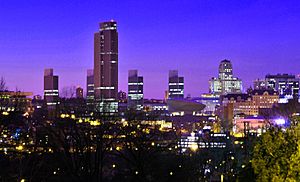
Albany County has two large shopping malls: Crossgates Mall in Guilderland and Colonie Center in Colonie. Both have over one million square feet of stores.
For kids, Huck Finn's Playland is an amusement park open in the summer. It opened in 2015 with rides from the old Hoffman's Playland. In winter, you can go snowshoeing on over 18 miles of trails at the Albany Pine Bush Preserve.
Museums and Art
Albany County has many historical sites and museums. The Albany Institute of History and Art, founded in 1791, is one of the oldest museums in the United States. The New York State Museum is the oldest and largest state museum in the country.
Many museums are historical buildings themselves, like Cherry Hill, the Ten Broeck Mansion, and the Schuyler Mansion in Albany. The Quackenbush House is the second oldest house in Albany and is part of the Albany Heritage Area Visitors Center, which has a planetarium.
The Albany Pine Bush Discovery Center teaches about the unique Pine Bush Barrens. You can also visit the Throop Drug Store Museum at the Albany College of Pharmacy. The USS Slater, DE-766, a World War II Destroyer Escort ship, is open for tours from spring to fall.
There are also several art museums, including the Albany Center Gallery and the University Art Museum. The Empire State Plaza in Albany has an important collection of modern art.
Performing Arts
The Times Union Center is the largest venue for performing arts in Albany County. It opened in 1990 with a concert by Frank Sinatra. Famous bands like The Grateful Dead have also performed there.
Sports and Athletes
Many famous athletes and coaches started their careers in Albany County. Phil Jackson, a well-known NBA coach, won his first championship with the Albany Patroons basketball team in 1984. Future NBA stars like Mario Elie and Vincent Askew also played for the Patroons.
Mike Tyson, the famous boxer, had his first professional fight in Albany in 1985. He fought several times in Albany and nearby cities early in his career.
The Siena College men's basketball team, the Siena Saints, has played in the NCAA Tournament six times since 1988.
Religious Life
Albany County was first settled by Protestants from northern Europe. In the 1800s, many Catholic immigrants came, especially from Ireland. Later, Jewish immigrants from eastern Europe also settled here. The county has one of the few Karaite Jewish communities outside of Israel.
Population and People
| Historical population | |||
|---|---|---|---|
| Census | Pop. | %± | |
| 1790 | 75,980 | — | |
| 1800 | 34,043 | −55.2% | |
| 1810 | 34,661 | 1.8% | |
| 1820 | 38,116 | 10.0% | |
| 1830 | 53,520 | 40.4% | |
| 1840 | 68,593 | 28.2% | |
| 1850 | 93,279 | 36.0% | |
| 1860 | 113,917 | 22.1% | |
| 1870 | 133,052 | 16.8% | |
| 1880 | 154,890 | 16.4% | |
| 1890 | 164,555 | 6.2% | |
| 1900 | 165,571 | 0.6% | |
| 1910 | 173,666 | 4.9% | |
| 1920 | 186,106 | 7.2% | |
| 1930 | 211,953 | 13.9% | |
| 1940 | 221,315 | 4.4% | |
| 1950 | 239,386 | 8.2% | |
| 1960 | 272,926 | 14.0% | |
| 1970 | 286,742 | 5.1% | |
| 1980 | 285,909 | −0.3% | |
| 1990 | 292,594 | 2.3% | |
| 2000 | 294,565 | 0.7% | |
| 2010 | 304,204 | 3.3% | |
| 2020 | 314,848 | 3.5% | |
| U.S. Decennial Census 1790–1960 1900–1990 1990–2000 2010–2019 |
|||
In 2020, the US Census counted 314,848 people living in Albany County. There were 126,540 households. The population density was about 563 people per square mile.
Most people in the county are White (78.2%), followed by Black or African American (12.7%), and Asian (4.8%). About 4.9% of the population is Hispanic or Latino. Many people have Irish, Italian, or German backgrounds. Most people (90.4%) speak English at home.
The average age of people in the county was 37 years old. About 22.6% of the population was under 18 years old.
2020 Census Details
| Race | Num. | Perc. |
|---|---|---|
| White (NH) | 210,895 | 67% |
| Black or African American (NH) | 40,667 | 13% |
| Native American (NH) | 494 | 0.16% |
| Asian (NH) | 24,363 | 7.7% |
| Pacific Islander (NH) | 166 | 0.05% |
| Other/Mixed (NH) | 16,668 | 5.3% |
| Hispanic or Latino | 21,595 | 6.85% |
Economy and Jobs
Tech Valley Growth
Since the 2000s, Albany County and the surrounding Capital District have focused on high technology industries. This area is known as Tech Valley. It's a name used to promote the Albany area as a high-tech hub, similar to Silicon Valley in California.
Tech Valley includes many counties in eastern New York. It has grown a lot in areas like nanotechnology, digital electronics design, and making microchips. This growth is supported by tech-focused schools like Rensselaer Polytechnic Institute.
Law Enforcement
The Albany County Sheriff's Department is one of the oldest law enforcement groups in the United States, started in the 1660s. The sheriff is also in charge of the county jail.
Education in Albany County
Colleges and Universities
- Albany College of Pharmacy
- Albany Law School
- Albany Medical College
- Bryant & Stratton College
- Excelsior College
- The College of Saint Rose (closed in 2024)
- Sage College of Albany
- Sage Graduate School
- Siena College
- State University of New York at Albany
K-12 Public Schools
Here are some of the public school districts in Albany County:
- Albany City School District
- Berne-Knox-Westerlo Central School District
- Bethlehem Central School District
- Cairo-Durham Central School District
- Cohoes City School District
- Duanesburg Central School District
- Green Island Union Free School District
- Greenville Central School District
- Guilderland Central School District
- Menands Union Free School District
- Middleburgh Central School District
- Niskayuna Central School District
- North Colonie Central School District
- Ravena-Coeymans-Selkirk Central School District
- Rotterdam-Mohonasen Central School District
- Schalmont Central School District
- Schoharie Central School District
- South Colonie Central School District
- Voorheesville Central School District
- Watervliet City School District
Transportation
Albany County has always been important for transportation. From early roads and canals to the first passenger railroad in New York, it has been a major crossroads. Today, Interstates, Amtrak trains, and the Albany International Airport keep Albany County a key travel spot in the Northeastern United States.
The Capital District Transportation Committee (CDTC) helps decide which transportation projects get federal funding. This ensures that important projects for the Albany area are supported.
Highways and Roads
Albany County is where major highways meet. Interstate 87 and Interstate 90 cross paths here. The New York State Thruway (a toll road) includes parts of both I-87 and I-90. I-87 goes south to connect with downstate New York and north towards Montreal. I-90 goes west to cities like Schenectady, Utica, and Buffalo, and east into Rensselaer County.
Interstate 787 connects the Thruway to Downtown Albany and other nearby towns. U.S. Route 9 and U.S. Route 20 are also important roads that run through the county.
Public Transportation
The Capital District Transportation Authority provides bus service in Albany County and four other nearby counties. Long-distance bus lines like Greyhound, Trailways, and Peter Pan Bus Lines also serve a terminal in downtown Albany.
Air Travel
Albany International Airport is the only commercial airport in the county. You can fly from Albany to many cities, including Atlanta, Las Vegas, Chicago, and Orlando.
Train Service
Albany County does not have its own train station anymore. Since 1968, the main train station has been the Albany-Rensselaer Station, located across the Hudson River in Rensselaer. Amtrak offers several routes from this station, connecting to cities like Montreal, New York City, Buffalo, Toronto, and Chicago.
Communities in Albany County
Albany County has three cities and 10 towns.
Cities
- Albany (This is the county seat, where the main government offices are)
- Cohoes
- Watervliet
Towns
Villages
Census-Designated Places (CDPs)
These are areas identified by the Census Bureau for statistical purposes.
Hamlets
Hamlets are small communities that are part of a town but are not officially incorporated as a city or village.
- Alcove
- Boght Corners
- Clarksville
- Coeymans
- Crescent Station
- Delmar
- Dunsbach Ferry
- Elsmere
- Feura Bush
- Fort Hunter
- Fullers
- Glenmont
- Guilderland
- Guilderland Center
- Karner
- Latham
- Lisha Kill
- Loudonville
- Mannsville
- McKownville
- Medusa
- New Salem
- Newtonville
- Normansville
- Roessleville
- Selkirk
- Slingerlands
- South Bethlehem
- Verdoy
- West Albany
Images for kids
-
The New York State Capitol in Albany
See also
 In Spanish: Condado de Albany (Nueva York) para niños
In Spanish: Condado de Albany (Nueva York) para niños




